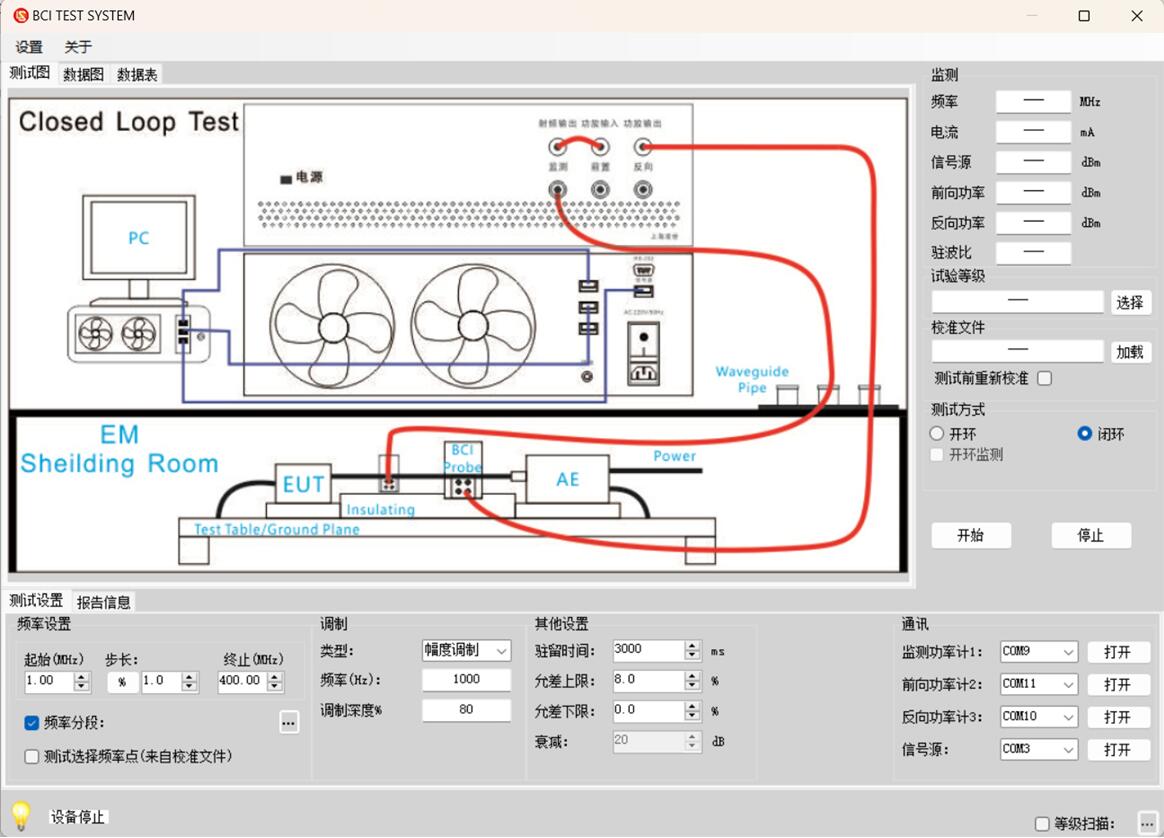Product No: LSBCI-40
LSBCI-40 Bulk Current Injection Test System(BCI)fully meet standard ISO 11452-4: 2011, GB/T 32960.2-2016, GB/T 17619 and GB/T 33014.4. The ultra-low starting frequency of 100KHz is sufficient to meet the testing requirements of global automobile companies. It has a built-in 3-channel power meter and can use a directional coupler to monitor forward and reverse power in real time.
Standard:
ISO 11452-4 “Road vehicles — Component test methods for electrical disturbances from narrowband radiated electromagnetic energy- Part 4:Harness excitation methods”
GB/T 32960.2-2016 “Technical specifications of remote service and management system for electric vehicles–Part 2: On-board terminal”
System configuration and technical parameters:
| 1. Test host | |
| Test Current | Open-loop test (substitution test) ≤300mA; Closed-loop test ≤200mA (fully automatic calibration, fully automatic test and output power monitoring during the test) |
| Output Impedance | 50Ω |
| Voltage Standing Wave Ratio | ≤1.2 |
| Chinese and English software | Support Win7,Win8和Win10,Win11 |
| 2. Signal Source (built-in) | |
| Frequency | 9kHz~3GHz |
| Output Level | -60~10dBm |
| Unmodulated signal | Continuous Wave |
| Modulation Mode | Amplitude modulation frequency:0.1Hz~500kHz;Modulation Depth:0~100% |
| Pulse modulation frequency:0.1Hz~20kHz;Duty Cycle:1~100% | |
| 3. Power Amplifier (built-in) | |
| Output Frequency | 100kHz~400MHz (Scalable to 1GHz) |
| Maximum Output Power | 125W(Linear Power) |
| Harmonic | <15dBc |
| 4. Power Meter (built-in) | |
| Input Frequency | 9kHz~3GHz |
| Input Power | -40dBm~+30dBm |
| 5. Directional coupler (built-in): coupling degree 40dB | |
| 6. F-120-6A Current Injection Probe: Maximum Input Power 1000W | |
| 7. F-52B Current Monitor Probe: Maximum Input Power 1000W | |
| 8. FCC-BCICF-1 Bulk Current Injection Probe Fixtures: a fixture for current injection probes | |
| 9. Artificial power network | |
| Comply with Standards | CISPR 16-1-2,CISPR 25,ISO 7637-2,ISO 11452-4,MIL-STD-461F,ECE R10 |
| Frequency Range/Impedance | 0.1~150 MHz / (5 µH + 1 Ohm) || 50 Ohm (+/- 10 %) |
| Maximum Continuous Current/Maximum Short-time Current | 200A/250A |
| Maximum Voltage | DC1000V, AC50/60Hz is 400Vrms, AC400Hz is 300Vrms |
| 10. Test Table | |
| BCI Test Table | 2*1*0.9m |
| BCI Grounding | The coupling plate edge strips are grounded at intervals of 300mm, and the aspect ratio of each ground strip is 7:1. Material: brass |
| Reference Ground Plane | 2*1*2mm,Material: Brass |
| 11. Electromagnetic shielding cabinet: SDR-4000B, internal dimensions are 4000*1200*1800mm (optional with additional cost, the dimensions can also be designed according to customer requirements) | |
Part 1: Test steps:
A. Before the test, verify that the disturbance current generated by the current injection probe meets the requirements in the calibration fixture, and then clamp the current probe to the specified position of the harness to be tested
B. Apply interference to the harness based on the forward power obtained by calibration. The current intensity is not monitored during the test, and the forward power is no longer adjusted
C. The length of the harness and the relative distance between the current injection probe and the harness to be tested will affect the coupling degree of the disturbance electromagnetic field on the harness to be tested
Part 2: Test result determination: The open-loop method is mainly divided into 5 levels, each level represents a different test result.
A. The function or performance of the EUT has been normal without any abnormality.
B. All functions or performances are in the interference state, one or more functions/performances deviate from the specified tolerance, but all functions or performances are restored to the specified tolerance limit after the interference is removed, and there should be no abnormality in the stored data.
C. One or more functions/performances are lost, but the EUT automatically recovers to normal mode after the interference is applied.
D. One or more functions/performances are lost, but they are restored to normal mode through human intervention after the interference is applied.
E. One or more functions/performances are lost, but they cannot be restored to normal mode after the interference is applied.
Part 3: Test system layout (refer to ISO 11452-4 Figure 2, Figure 1 and Figure 3):
1. Reference ground plane: The reference ground plane uses a metal plate with a thickness greater than 0.5mm, preferably brass. The length and width of the test bench and the reference ground plane are at least 1700×1000mm; the impedance of the grounding material is not greater than 2.5 milliohms, and the interval is not greater than 300mm;
2. Artificial power network: For remote grounding, 2 artificial power networks are required, and for near-end grounding, only 1 artificial power network (connected to the positive pole) is required;
3. Placement of EUT: The product under test should be placed on an insulating material with a low dielectric constant (not greater than 1.4) and a thickness of 50 (±5) mm. The total length of the test harness EUT and the simulated load harness should be: 1000 (±100) mm, and the test harness should be placed on an insulating material with a dielectric constant (not greater than 1.4) and a thickness of 50 (±5) mm.
4. High current injection probe: The distance d between the injection probe and the EUT is as follows:
d=(150±10)mm
d=(450±10)mm
d=(750±10)mm

ISO 11452-4:2020 Figrue 2
Part 4: Test Report Sample:

LSBCI-40 Data

LSBCI-40 Open Loop Test

LSBCI-40 Closed Loop Test